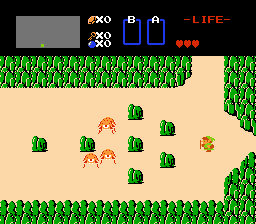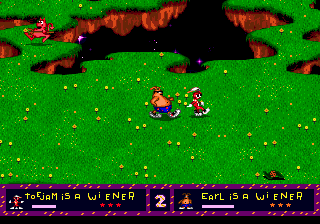I don’t like the idea of ‘retro gaming’. That is to say, I don’t like using the term ‘retro’ to describe games released several years ago. It seems to imply that old games (encapsulated as a single monolithic entity) should be treated differently to newer games. This distinction comes from a misunderstanding of why people play old games. I play lots of old games and I’m not for a single second trying to ‘relive’ anything. I have no interest in nostalgia, I’m just aware that some old games haven’t aged badly in any important respect, and in a few cases haven’t been subsequently bettered either. Furthermore my ability to appreciate them (logically enough) hasn’t remained static.
The negative aspects of isolating old games cut both ways. It casts old games in an unnecessarily poor light by encouraging people (especially the OH SO WACKY NES T-shirt brigade) to focus on the technical limitations instead of the ingenuity with which developers tried to overcome them. It also suggests that good and bad decisions made in the design of crumbly old games have no relevance to our clearly much more sophisticated modern ones.
The upshot of this is that newer games often only compared to their contemporaries, mediocre games are reluctantly endorsed by reviewers, and developers make mistakes that were avoidable years before. (Trivial example: you’d think that by now everyone would know that mapping ‘up’ on the joystick to ‘jump’ was a big no-no, yet it still happens.) A good example of how constructing an artificial divide between old and new games can be counterproductive is this recent Eurogamer article.
In this multi-part feature, Eurogamer present an overview of all of the games that have so far been launched on Nintendo’s Wii Virtual Console service, from the perspective of a modern consumer. The task of sampling all 40-odd games fell to one person, veteran Eurogamer contributor Kristan Reed.
It is apparent from the antagonistic tone of the introduction that sensitive (i.e. sensible) readers are in for a rough ride. The author clearly has a bee in his bonnet about the idea of old games being shielded from criticism for the sake of nostalgia, as well he might. Unfortunately, this policy of nostalgia-free reassessment is applied rather unevenly, resulting in all the games that the author hasn’t previously played being dismissed out of hand, while any games that were critically and commercially successful (read: massive sacred cows) at the time of release get the kind of soft pedal treatment usually reserved for Prince Harry’s school reports.
Let’s see what Mr. Reed has to say about the original Legend of Zelda, an influential gaming landmark at the time of it’s release 21 years ago, but one which was rendered entirely obsolete by later sequel/updates and has dated almost to the point of unplayable incoherence today:

“Another hugely important NES title for obvious reasons, and one that still has enough compelling elements to make it worth investigating 20 years on […]
Somewhat limited by memory restraints, the narrative element is distinctly lacking in this first Zelda outing, but the cryptic clues nevertheless lend it an enigmatic quality that makes it challenging and addictive – even now. Meanwhile, the gradual upgrade system, quest structure and combat still feels close enough to the Zeldas we know now to make it enjoyable. Needless to say, the visuals are beyond simplistic by today’s standards, and the ‘combat’ is hilariously basic at first, so it might take a fair while to get into this as a newcomer. But for the sake of 500 measly points it’s well worth having stored on your Wii if you’re a slave to Zelda. For the rest of you, maybe best wait for Link to the Past to get a VC release…
Retro rating: Four stars [out of five]”
How many apologies can you spot? Granted, the review reluctantly concedes at the end that you’d be better off waiting for the SNES version to be released on the Virtual Console service, but it seems desperate up to that point to gloss over the game’s mouldering interface, substandard localisation and almost homeopathically diluted sense of fun to cajole you into trying it, if only for curiosity’s sake. Why?
By way of contrast, let’s compare a later installment’s remarks on Toejam & Earl, the early Mega Drive arcade adventure which had the misfortune to be eclipsed by Sonic on its home format, and while still regarded as a timeless classic by most well-informed critics, never benefited from the saturation media coverage (and mandatory Nintendo affiliation) that would have afforded it Sacred Cow status in the eyes of EDGE and America’s Internet:

“What a thoroughly odd little game. You guide a three-legged red alien or a fat orange alien across simplistic green landscapes in search of pieces of their spaceship, and try to avoid the various Earthling enemies that shuffle around in their way.
With a shuffling gait and an inability to get a bloody move on, boredom rapidly sets in as you slowly waddle from place to place, picking up power-ups and random tat with little explanation, and even less incentive for doing so. The main innovation was the inclusion of a two-player co-op facility, allowing the screen to split into two if you strayed too far from one another.
Don’t bother with this one unless you’ve got some peculiar urge to be disappointed with your childhood.
Retro rating: Two stars.”
Hopefully it’s obvious that that’s a load of horseshit*. This exasperatingly wrong review makes it plain that the reviewer had never played the game before, didn’t bother to read the manual, and played for a scant few minutes before rejecting it for not consisting of linear, hand-holding, heavily signposted instant gratification.
It’s not like the game even has a steep learning curve, it just requires some modest level of patience and open-mindedness to get into at first. As the reviewer is unwilling or unable to meet these demands, the reader is denied an appraisal of the many unique aspects of the game that are the reason it is viewed with such affection by most players.
Aspects such as the deftly balanced randomness, heavily influenced by Rogue, which has the effect of extending the game’s life indefinitely. Even experienced players who have discovered all of the (many, many) gameplay quirks and random gags can’t expect to breeze through the game every time (or at least, not quickly).
This randomness runs amok on the fantastic cooperative mode, which allows for useful teamwork and strategy, and goes out of it’s way to prevent unskilled (or unlucky) players from being punished, provided their companion has at least a sliver of compassion in their cold black heart.
Then there’s the warmth and inclusiveness of the writing and characterisation. The shock of a game with a conversational tone (and, well, fart gags) at a time when most console and arcade games read like a non-native English speaker trying to appeal to G.I. Joe’s demographic while using maybe a dozen words per level is difficult to imagine today, in the wake of the countless games featuring committee-designed ‘attitude’-heavy characters which followed. Toejam & Earl represents the eye of the storm, where you could make a game about two guys who weren’t anonymous ciphers, nor brash and calculatedly obnoxious ‘radical dudes’. They were just a couple of average xenomorphs – naive, good-natured and relatively sympathetic.
Getting back to the Eurogamer article, I don’t know whether the blame ultimately lies with the conditions under which it was written (it can’t be easy to play forty games for a long enough amount of time to be able to make an informed comment about them while constrained by deadlines – a group effort, or longer reviews for the few above-average VC titles might have been more appropriate), or with the reviewer’s short attention span and sour attitude to old games.
Elsewhere in the piece Gunstar Heroes is criticised for being too difficult (it isn’t, excessively) with the words “it’ll give you a bloody nose if you’re not ready to invest endless repeat play required,” as if someone might try to play an arcade-style action game that you can clock in one sitting for the narrative, or something. We’re also informed in the introduction that “many people just can’t tolerate the way old games look.” What people? Idiots? Sniffy, contemptible dimwits who have taken it upon themselves to be deliberately contrary? I could go on, but I think you get the idea.
We can learn from this sorry episode that there are at least two assumptions that reviewers of old games need to be aware of:
1. Not every idea, style or convention that falls out of favour does so because something better came along to replace it. Genres can become overcrowded, or exploited for so long and so intensively that there’s no further room for meaningful improvement (scrolling beat-’em-ups are a classic example of this). Players’ tastes can shift, and they are (frequently) blinded by technological novelties in the short term. Going back to old games should be an opportunity to experience them without these attendant pressures.
2. The reputation that a game manages to acquire (or not) near the time of it’s release is not necessarily an accurate (or enduring) indicator of it’s quality. This is especially true when considering games from before the rise of the internet, when the amount and quality of information available to the potential purchaser was extremely minimal.
*To compound the inanity, Toejam & Earl is given the same star rating as the dire Altered Beast. And to pull Eurogamer’s Escher-like ratings system into a bizarre nine-dimensional möbius loop, the half-arsed Mega Drive port of Golden Axe gets one more star than either of them. Absurd.
Tags: commentary, eurogamer, retro, toejam & earl
